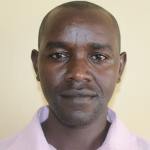328 students and 27 staff at Gavudunyi Secondary School face the challenge of not having enough water to meet their needs. The meager water they are able to collect is very likely to make them sick, putting their hope of a good education even further behind.

The school has a rain tank on campus where students go to collect water first, but the tank is far too small to serve the large school population, so it runs dry quickly. When the tank does hold water, students report that it often makes them sick with stomachaches because the tank is not regularly cleaned.

Students wait to collect water from the rain tank on campus.
As expected, when students are ill, they often leave class and miss out on valuable learning time. But missing out on their education is not the only expense because their families also have to spend their minimal resources on medication for students to feel better, stealing from other important needs.
"Consumption of contaminated water causes sickness, and people, especially the students, miss school due to sickness. Many students requested permission to go home and seek medical attention due to stomachache last week. I feel like we are endangering the lives of [our] students and have failed to provide them with safe water as a school," shared 34-year-old teacher Godfrey Nyandieka.

Teacher Mr. Godfrey Nyandieka.
"Teachers carry drinking water from their homes as a way of avoiding water-related diseases," Godfrey said.
"I sometimes ask myself questions as to how, at this age, we should still be having water problems, where our children have to suffer after drinking water, which is essential for life," he continued.
When the tank is dry, students are thirsty, so they must leave the school and visit a nearby primary school with a well to collect water. They are glad to have access to safe water to collect, but their access is limited and time-consuming. The water is often rationed, saving it for primary school students, which is understandable, but it is disheartening and frustrating to be turned away when you are thirsty.

Mr. Nyandieka collects water with students.
When they are granted access, they usually wait in long lines to get water. This consumes time meant to be spent in the classroom learning, putting students further behind.
"The longest time taken to wait for water is 30 minutes; this is due to the fact that congestion at the waterpoint is inevitable, and one must wait for those ahead of them to fetch water first before their turn," reported Mr. Nyandieka.
The students and staff need access to their own reliable, safe water source to have plenty of water to drink and meet their daily needs, but they still need time in the classroom to focus on learning and building brighter futures.
"The proposed water solution will help solve the schools' problems by allowing them to have their [own] water source within the premise and can access it at any time without restrictions or begging for water from the primary school section," said Field Officer Wilson Kipchoge.
Steps Toward a Solution
Our technical experts worked with the local community to identify the most effective solution to their water crisis. They decided to drill a borehole well, construct a platform for the well, and attach a hand pump.
Well
Abundant water often lies just beneath our feet. Aquifers—natural underground rivers—flow through layers of sediment and rock, offering a constant supply of safe water. A borehole well is drilled deep into the earth to access this naturally filtered and protected water. We penetrate meters, sometimes even hundreds of meters, of soil, silt, rock, and more to reach the water underground. Once found, we construct a platform for the well and attach a hand pump. The community gains a safe, enclosed water source capable of providing approximately five gallons of water per minute. Learn more here!
Handwashing Stations
Alongside each water source, we install two gravity-fed handwashing stations, enabling everyone at the school to wash their hands. Handwashing is crucial for preventing water-related illnesses within the school and community. Student “health clubs” maintain the stations, fill them with water, and supply them with soap, which we often teach them how to make.
Latrines
We will construct two Ventilated Improved Pit (VIP) latrine blocks designed to prevent fecal disease transmission. Each latrine features a cement floor, making it easy to use and clean regularly. Three stalls will serve the girls, and three will serve the boys.
School Education & Ownership
Hygiene and sanitation training are integral to our water projects. Training is tailored to each school's specific needs and includes key topics such as proper water handling, improved hygiene practices, disease transmission prevention, and care of the new water point.
To ensure a lasting impact, we support forming a student health club composed of elected student representatives and a teacher. These clubs promote hygiene practices schoolwide and keep handwashing stations well-stocked. This student-led model encourages a sense of ownership and responsibility.
Safe water and improved hygiene habits foster a healthier future for everyone in the school and the surrounding community.

 Borehole Well and Hand Pump
Borehole Well and Hand Pump
 Rehabilitation Project
Rehabilitation Project




















